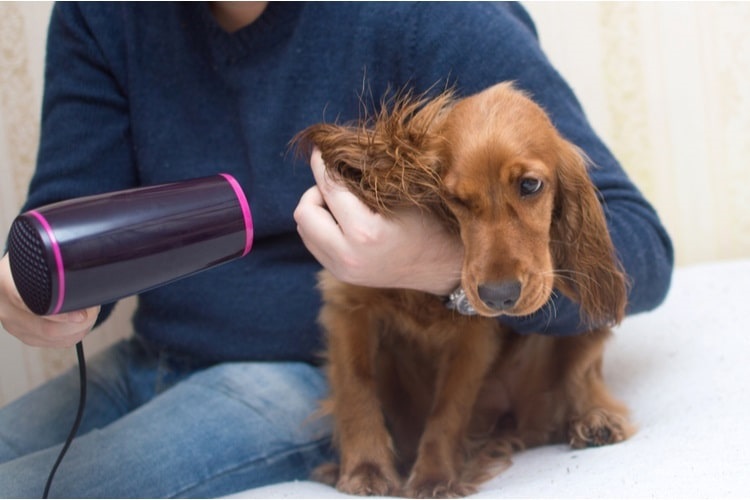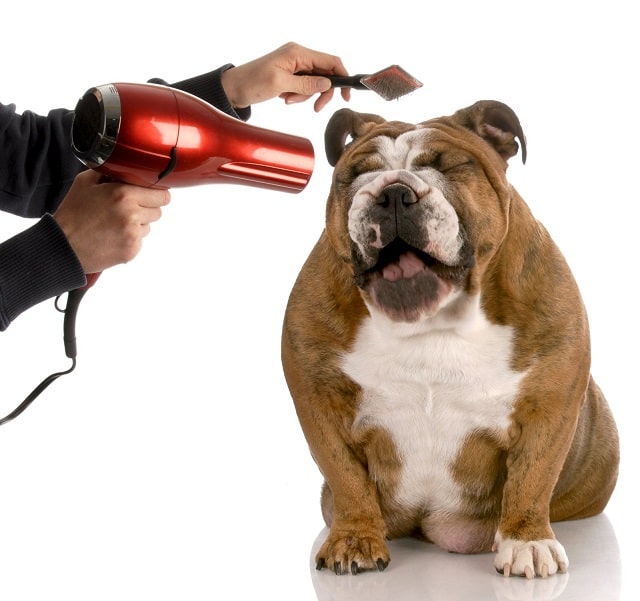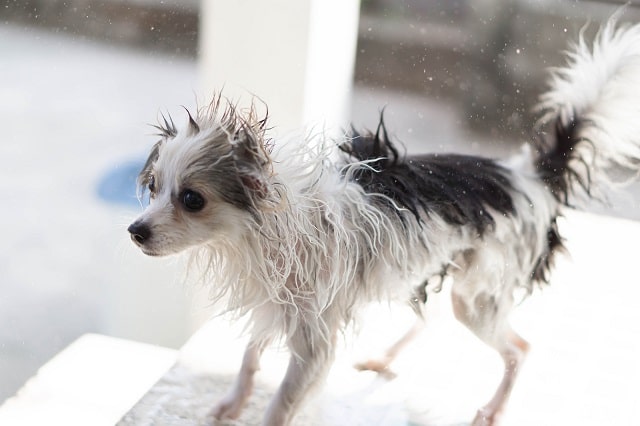As a dog owner, there will always be a need to give your dog a bath at some point, so you might be wondering if it’s safe to blow dry a dog. Even for those dog owners who typically use a dog groomer, there are moments when you will need to give a bath at home. For example, when your dog rolls in the mud, becomes dirty while out hiking, or your toddler spills dinner on them.
Some people choose to routinely bathe and dry their dogs at home. Grooming your pup at home saves time and money and can be more convenient.
So, you have given your dog a bath. What next? Can you use a blow dryer? The short answer is yes; however, there are some safety precautions you need to take. This article will give you the information you need to safely blow dry your dog.
What Type of Blow Dryer Do I Need?
To blow dry your dog in a safe manner, you need to obtain a dog hair dryer. Dog hair dryers are designed to be the right temperature for your dog. There are many types of dog hair dryers to choose from. The various styles allow you to choose the dog dryer that is most convenient for you depending upon your goals and budget. You can check our guide to purchasing the best dog dryer to select the right blow dryer for your particular dog’s haircoat.1
How Do I Get My Dog Used to a Blow Dryer?
The first time you get out your dog hair dryer, don’t plan on actually drying a wet dog! The best way to get your dog used to the hair dryer is by starting slowly and using lots of patience.
Some dogs are afraid of loud noises, so starting slowly and gradually helps to desensitize your dog to the hair dryer and the noise it makes.2 If your dog is fearful of loud noises, you’re not alone. According to VCA Hospitals, it’s estimated that one-third of dogs are affected by noise aversions.3
I suggest starting by having the blow dryer out at a time when you don’t bathe your dog. Start by offering rewards, treats or toys, to your dog while you hold the blow dryer.4 The dryer will be off the first time you do this. Then, gradually you pretend to use the dryer, eventually turn the dryer on at a low air volume.
As you introduce each stage, keep rewarding your dog with treats or toys. Once your dog is content with the dryer being on, then you use the dryer for just a few minutes, working your way up to a full drying time. At this point, you are ready to use the dryer on a wet dog! The time it takes to get your dog used to the dryer depends on your dog’s reaction to drying.
Always make sure you have your dog in a safe and secure environment. Never have your dog on a table with a leash and walk away.
Finally, don’t worry or be nervous yourself. This will make your dog nervous too. Take each step with confidence and the blow drying experience will go much more easily.
Quick Tips and Tricks to Blow Dry a Dog Safely
Now that your dog is ready for the hair dryer, here are some quick tips and tricks to make the process go smoothly. Remember, patience is key.
Set up your towels and dog dryer prior to bathing your dog.
After the bath, towel dry your dog first to help get some of the moisture off your pet. Using an appropriately sized towel, gently rub the fur. After you do this, your dog will want to shake. Make sure to give them room to shake. I often hold the towel up so I don’t get soaked! Dogs can remove quite a bit of water when they shake their bodies. After towel drying, move on to the hair dryer.
For cage dryers, which are more commonly used in a grooming facility, the most important tip is to make sure the dog is not getting too hot. Make sure to follow the dryer’s directions completely, use a timer if equipped, and check on your dog routinely. If you are at all concerned, turn the heat level down or turn off the dryer. There are dryers you can purchase that do not have heat elements, and this can help to reduce the risk of overheating.5
For all other dryers, you will be directing the airflow. Start by setting up your dog and yourself in a comfortable position. Turn on the dryer and aim the nozzle/hose at the trunk of your dog’s body, starting near the rear end. Then use a gentle back and forth motion to dry the fur, ensuring that you keep moving and don’t hold the dryer in one place for any length of time. It is also key to use the dryer toward then away from the coat, making sure the fur is blowing away from the dryer. If the hair coat is blowing back and forth, tangles and irritation may occur.
When drying the head and neck, decrease the airflow if possible or hold your dryer further back. Gently go around the neck and back of the head. Avoid direct airflow into the ears and eyes.
It is ok if your dog is 99% dry when you stop blow drying. You don’t need to dry your dog completely with the hair dryer. Brushing your dog using a slicker brush can actually help the fur dry further. Also, allowing the final moisture to air-dry is acceptable as well.
Finally, make sure to follow all instructions that come with your dog blow dryer.
What Is Not Safe When Blow Drying my Dog?
These are some things to avoid when it comes to safely blow drying your dog. First and foremost, it’s best to avoid using a human hair dryer. According to Encyclopedia.com, human hair dryers can reach temperatures of 140 degrees.6
Most dog dryers have “no heat” or minimally warmed air. Human hair dryers are hotter and have less air volume than dryers made for dogs. The high heat is dangerous for your dog’s skin, and it can burn if you are not careful.
Do not leave your dog unattended while using any dog blow dryer. Even with dog hair dryers, if they have a warming element, it is possible for your dog to overheat. So make sure that you don’t continue using a hair dryer once your dog is dry. If you notice your dog is panting excessively, lethargic, vomits, or has diarrhea, seek advice from your veterinarian immediately.
Lastly, make sure to get your dog used to the hair dryer before using it on wet fur. If your dog is too anxious she may try to escape, pull on the leash, or hurt herself. Taking the time to handle your dog properly will help to avoid these complications.
Conclusion
Being able to blow dry your dog at home is safe and convenient. Do not be afraid to try this yourself. Just make sure to set up for success by having the right tools and techniques as described here. Once you’re prepared grooming your dog can be a very rewarding experience.
If you’re looking for additional resources to help keep your puppy healthy and looking good we also have a series of buying guides to help you select a good dog ear cleaner, the best dog trimmers, grooming clippers for poodles, and our guide to finding the best brush for an Australian Shepherd.
Article Sources
Pet News Daily uses only high-quality sources, including peer-reviewed studies, to support the facts within our articles. Read our editorial process to learn more about how we fact-check and keep our content accurate, reliable, and trustworthy.
- Cadieu E, Neff MW, Quignon P, et al. Coat variation in the domestic dog is governed by variants in three genes. Science. 2009;326(5949):150-153. doi:10.1126/science.1177808
- Animal Behavior College. Easing Your Dog’s Fear of Loud Noises. Animalbehaviorcollege.com. Accessed March 13, 2021.
- Martin K, Horwitz D, Landsberg G. Fear of Noises in Dogs. Vcahospitals.com. Accessed March 13, 2021.
- Todd Z. What is Desensitization and Counter-Conditioning in Dog Training? Companionanimalpsychology.com. Published July 11, 2018. Accessed March 13, 2021.
- Hall EJ, Carter AJ, O’Neill DG. Incidence and risk factors for heat-related illness (heatstroke) in UK dogs under primary veterinary care in 2016. Sci Rep 2020;10. doi:10.1038/s41598-020-66015-8
- Hair Dryer. Encyclopedia.com. Updated May 14, 2018. Accessed March 14, 2021.



